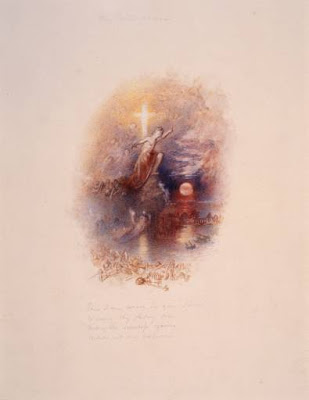The Last Man theme, however, extended far beyond literature, and a number of visual depictions of the Last Man were produced at the beginning of the nineteenth century. The majority of these paintings appear to respond to Thomas Campbell's short poem 'The Last Man' (1823), in which 'skeletons of nations' surround the lonely figure of the Last Man as he watches ships 'drifting with the dead' to shores 'where all was dumb' (you can find the full text of the poem here.) Although these images are all undeniably rather bleak, the poem is nevertheless ultimately very optimistic, with the Last Man retaining his faith in God throughout.
The first artist to respond to Campbell's poem was John Martin, a painter famous for his love of dramatic - and often apocalyptic - subjects. Martin made several sketches of the Last Man theme in the 1820s, before producing a watercolour in 1832, and then finally an oil painting in 1849. Martin clearly visualises the Last Man as a Christ-like figure, standing high on a cliff with open arms as he surveys the dying sun slowly dimming over a deserted and desolate landscape.
 |
| John Martin's watercolour of 1832 © Laing Art Gallery |
 |
| John Martin's oil painting of 1849 © Walker Art Gallery |
The Christian outlook of Campbell's poem is even more apparent in another picture of the Last Man that was based on this text: J. M. W. Turner's 'The Last Man' (1837). In this painting, the Last Man is a tower of strength and faith, kneeling - just in case you missed those comparisons with Christ(!) - in front of a huge, glowing cross.
 |
| J. M. W. Turner's 'The Last Man' (1837) © National Gallery of Scotland |
Campbell's poem, however, didn't just inspire the art world. In 1826, an operatic scene based on Campbell's text and set to music by William H. Callcott was performed to rave reviews. The Quarterly
Musical Magazine and Review commended the composer’s choice of poem,
observing that the composition ‘is really a work in which genius shews [sic]
forth’. Other publications recommended the piece as a ‘pleasure’ to hear, and called it ‘a composition of no ordinary kind’; indeed,
this work proved so popular that it was performed again in 1827, 1828, and 1830.
After 1830, though, the opera appears to have been forgotten. When I came across references to it over the course of my research I was always intrigued to know what it would have sounded like, and this summer I was delighted to work with the Waste Paper Opera Company to revive the piece at a conference I was organising. The song was amazing to hear performed, and was both haunting and powerful. Following feedback from the conference delegates, we decided that the piece should be made available for a wider audience to enjoy and started to look for opportunities to perform it in public.
The perfect opportunity arose in 'FRIGHTFriday', a collaboration between the Ashmolean Museum and The Oxford Research Centre in the Humanities (TORCH) that was organised as part of the Being Human festival. The event saw humanities research centred on the theme of 'Hopes and Fears' opened up to the public, with our performance of the apocalyptic 'The Last Man' opera falling very much into the latter category! The darkness of the Still Life gallery at the Ashmolean provided the perfect backdrop for the piece, with the scenes of tables laden with food reminding me of the abandoned meal that Lionel Verney encounters in Mary Shelley's The Last Man as he wanders across Italy in search of fellow survivors.
The score was arranged by James Olden (who also directed the performance), and the producer of the piece was Klara Kofen. Przemyslaw Baranek (baritone), Sarah Farmer (violin), and Paul Zaba (accordion) really brought the opera to life, and the song was complemented by readings of extracts from other contemporary Last Man texts. I now hope to have the piece recorded professionally so that even more people can hear it - watch this space for further news!
You can find out more about the Last Man opera, and the other FRIGHTFriday projects, here.
You can find out more about the Last Man opera, and the other FRIGHTFriday projects, here.
 |
| I introduce the Last Man theme at the start of the performance |
 |
| Sarah, James, and Paul perform some extracts from Mary Shelley, Byron, and Pitt |
 |
| Paul accompanies Przemyslaw as he sings Campbell's words |
 |
| Przemyslaw performs the operatic song, accompanied by Sarah |
No comments:
Post a Comment
Note: only a member of this blog may post a comment.